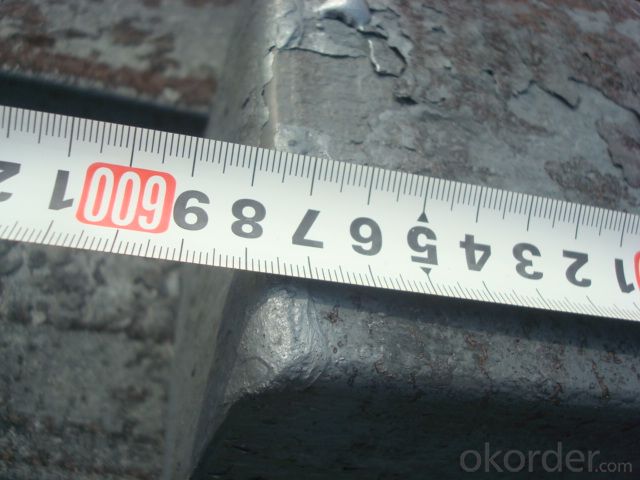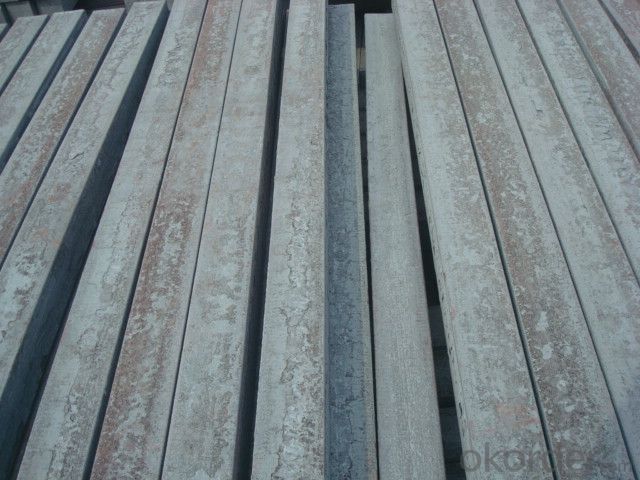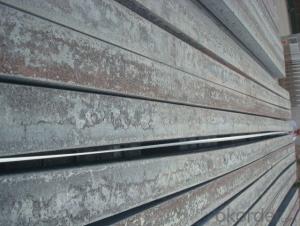Steel Billets Manufactured by Continue Casting
- Loading Port:
- Tianjin
- Payment Terms:
- TT OR LC
- Min Order Qty:
- 1000 m.t.
- Supply Capability:
- 10000 m.t./month
OKorder Service Pledge
OKorder Financial Service
You Might Also Like
Steel Billets Manufactured by Continue Casting
1.Structure of Steel Billets Manufactured by Continue Casting
Steel Billets Manufactured by Continue Casting is the raw material of all kinds of steel mill. Billet section of square, round, flat, rectangular and abnormity, etc Several, mainly related to shape of rolled products. Simple rolled section steel, choose cross section of square billet or rectangular billet. rolling The sector products such as flat steel, Angle steel, select the rectangular billet or slab. Had better profiled billet when production beams, channels, and in rolling process Lines and improve the yield. The raw material of round billet is the production of seamless tube.
2.Main Features of Steel Billets Manufactured by Continue Casting.
Steel Billets Manufactured by Continue Casting section size should meet the requirements of rolling deformation and finished product quality, but also roll strength and biting condition of restrictions. General steel Billet section height H. And the roll diameter D The ratio of the ( namely H/D) Should be less than or equal to zero 0.5 . Length of steel billet by finishing temperature, Rolling time and the length of the product Or times ruler. When heated too long accident prone to bump the furnace wall of steel, too short, furnace bottom utilization rate is not high, influence the heating furnace production. For the production Choose a variety of steel and steel billet, should consider the affinities of billet, as far as possible in order to improve the productivity of the roughing mill, simplify the stock management of workshop.
There are three shapes of the steel billets: square billet, slab, rectangular billet The Chinese billet, rectangular billet is mainly suitable for rolling hot rolled strip, building reinforced bar, Ordinary wire, high speed wire rod and various small profile. Of the slab are mainly used for rolling plate and hot coil sheet.
3. Steel Billets Manufactured by Continue Casting Images


4. Steel Billets Manufactured by Continue Casting Specification
Steel Billets Manufactured by Continue Casting rolled steel, after processing can be used for mechanical parts, forging parts, processing all kinds of steel, steel Q345B channel steel, wire rod is the role of the billet. Steel billet is used in the production of semi-finished products, generally cannot be used directly for the society. Steel billets and steel are strictly divided into standard, cannot decide to whether the business enterprise of the final product, and according to unified standards to perform the whole society. Typically, billet and the steel is relatively easy to distinguish, but for some steel billet, and have the same specification and same steel purposes (such as rolling tube billet), whether can be used for other industries, whether through steel processing process, whether through a finished product rolling mill processing to distinguish
Material standard The editor Range of thickness: 150-240 - mm + / - 5 mm width range: 880-1530 - mm + / - 20 mm Length: 3700-10000 - mm + / - 500 - mm Cross-sectional size: 64 * 64; 82 * 82; 98 * 98; 124 * 124; 120 * 150; 152 * 164; 152 * 170 mm Length: 9000 mm Section of tolerance: billet: 1.0 + / - 2.0-1.0 + / - 1.0 mm slab: width: + / - 2.0 mm thickness: + / - 3.0 mm The length tolerance: + / - 200 mm Section diagonal tolerance: 3.5-8.0 MM Billet section size protrusions requirements: < 1242 mm, do not allow; > = 1242 mm, < = 2 mm 1242 mm, < = 3 mm Beheading (shear) extension deformation: < 1242 mm billet: no control; The slab: < = 15 mm Surface tilt: no more than billet section 0.1 Bending: every 1 m length is not more than 10 mm The distortion: length < = 5 m, < = 11. ; The length of the < = 7.5 M, < = 5. Material % 3 sp/PS chemical composition: C Mn Si S P
5.FAQ of Steel Billets Manufactured by Continue Casting
We have organized several common questions for our clients,may help you sincerely:
①How about your company?
A world class manufacturer & supplier of castings forging in carbon steel and alloy steel,is one of the large-scale professional investment casting production bases in China,consisting of both casting foundry forging and machining factory. Annually more than 8000 tons Precision casting and forging parts are exported to markets in Europe,America and Japan. OEM casting and forging service available according to customer’s requirements.
②How to guarantee the quality of the products?
We have established the international advanced quality management system,every link from raw material to final product we have strict quality test;We resolutely put an end to unqualified products flowing into the market. At the same time, we will provide necessary follow-up service assurance.
③What is the advantage of the continue Casting steel billet comparing to the die casting steel billet?And how is the process?
Compared with die casting, continuous casting has the advantages of: 1. To simplify the Steel billet The production process 2. Improve the metal yield 3. Improve the quality of the billet 4. Reduces the steel worker's labor intensity 5. Save energy and reduce consumption
Steel billet is produced by the method of through three processes: It is through the steelmaking system of continuous casting equipment, directly by the molten steel pouring into billet; The second is the steelmaking system in the production of steel ingot casting billet through system of steel rolling rolling equipment or processing of steel semi-finished products; Three is the steelmaking system production of steel ingot by forging the semi-finished product processing equipment.
- Q:I want to buy a fishing pole, I don't know how to distinguish it. Know what, please reply, thank you, [em10]!
- The tonality of a fishing rod is actually modulated by a different modulus of carbon cloth.Some fishing overall with the 30T following carbon cloth, just use a very small amount of 40T or 46T carbon cloth, called high carbon rod, is actually confuse the public practice of fishing by weighing, hand identification, high carbon rod with real light, hard, two rods in a play, a ratio is obvious.
- Q:What is the average lifespan of a steel billet in the automotive industry?
- The average lifespan of a steel billet in the automotive industry can vary depending on various factors. However, in general, steel billets are typically used as raw materials for the production of automotive parts such as engine components, chassis, and body structures. These parts are designed to have a long lifespan, typically lasting the lifetime of the vehicle itself, which can range from 10 to 20 years or more. The specific duration of a steel billet's lifespan within the automotive industry can also depend on the specific application and the level of stress or wear it undergoes during its service. For instance, engine components like crankshafts or connecting rods may experience higher levels of stress and wear due to the combustion process, potentially requiring replacement or refurbishment after a certain period. Additionally, advancements in material science and manufacturing technologies have led to the development of stronger and more durable steel alloys, further extending the lifespan of automotive parts. These advancements, coupled with regular maintenance and proper usage of the vehicle, contribute to the longevity of steel billets used in the automotive industry. It is essential to note that the lifespan of a steel billet can be influenced by other factors like corrosion, environmental conditions, and the overall quality of the manufacturing process. Therefore, manufacturers and automotive companies prioritize quality control measures to ensure the longevity and reliability of their products. In conclusion, while the specific lifespan of a steel billet in the automotive industry can vary, it is generally designed to last the lifetime of the vehicle, which can range from a decade to multiple decades. Advances in materials and manufacturing techniques enhance the durability and overall performance of steel billets, ensuring their longevity in automotive applications.
- Q:What is the cost of a steel billet?
- The cost of a steel billet can change based on several factors including size, grade, and market conditions. Steel billets are semi-finished products used as raw materials for various steel products. The price of a steel billet is typically given per metric ton. To determine the cost, one needs to consider the current market price of steel, which can fluctuate due to factors such as supply and demand, international trade policies, and global economic conditions. Furthermore, the grade of the steel billet can impact the cost since different grades have different levels of purity and specifications. It is crucial to contact steel suppliers or refer to market reports for accurate and current information on the cost of steel billets. Additionally, additional factors like transportation and handling costs may also affect the final price.
- Q:How are steel billets used in the manufacturing of industrial valves?
- Steel billets are used in the manufacturing of industrial valves as they serve as the raw material for forging and shaping various valve components, such as the body, bonnet, and stem. These billets are heated, and through a process called hot forging, they are transformed into the desired shape and size of the valve parts. The use of steel billets ensures the strength, durability, and integrity of the valves, making them suitable for demanding industrial applications.
- Q:What is the active carbon. What is the difference with the charcoal?
- The chemical activation method. The activator of discharged gas, or by activating agent impregnated material, after the high temperature treatment can be activated carbon. The activated carbon has a microcrystalline structure, crystallite alignment completely irregular. The micro crystal (radius of less than 20, a: = 10-10 m), transition hole (radius 20 ~ 1000), big hole (radius of 1000 ~ 100000), so it has great inner surface, the surface area of 500 to 1700 meters / 2 grams.
- Q:What are the different surface finishes available for tool steel billets?
- There are several surface finishes available for tool steel billets, including mill finish, hot rolled, cold rolled, ground, and polished. Each finish has its own characteristics and is used for specific purposes. Mill finish is the raw surface of the billet after it has been manufactured, while hot rolled has a rougher texture due to the high temperature rolling process. Cold rolled billets have a smoother surface and tighter dimensional tolerances. Ground finish involves grinding the surface to achieve a specific level of smoothness and precision. Finally, polished finish provides the highest level of smoothness and reflectivity, often used for aesthetic purposes or in applications requiring minimal friction.
- Q:How are steel billets transported?
- Various modes of transportation are employed to transport steel billets, depending on the distance and availability of infrastructure. Trucks or lorries are commonly used, particularly for shorter distances or when the delivery location is difficult to reach by other means. To ensure stability during transit, the steel billets are loaded onto flatbed trucks or placed in containers and securely fastened. For longer distances or when a large quantity of steel billets needs to be transported, railways are often utilized. Rail transport allows for the movement of heavy loads and is a more cost-effective option compared to other modes of transportation. Specialized railcars, either open-top or covered, are used to load and secure the steel billets, preventing any damage or displacement during the journey. In certain cases, such as overseas shipments or transportation to areas without railway access, sea freight may be employed to transport steel billets. Shipping containers are typically used to load the billets onto cargo vessels. This method is suitable for large quantities of steel billets and offers the advantage of worldwide transportation. Regardless of the chosen mode of transportation, it is essential to handle steel billets with care and ensure proper securing to prevent shifting or damage during transit. Specialized equipment and vehicles, such as cranes or forklifts, may be necessary at both the loading and unloading points to safely handle and transfer the steel billets.
- Q:How do steel billets contribute to the overall thermal insulation of a structure?
- Steel billets do not contribute to the overall thermal insulation of a structure. In fact, steel is a good conductor of heat and can transfer heat quickly, making it a poor choice for thermal insulation.
- Q:What are the specifications for alloy steel billets used in the defense industry?
- The defense industry requires alloy steel billets that meet specific criteria for each project. However, there are commonly followed specifications. Firstly, strict material standards must be met, and certification to military or industry specifications is necessary. These specifications cover the chemical composition, mechanical properties, and heat treatment of the alloy steel. The chemical composition is crucial as it determines the material's strength, hardness, and resistance to corrosion and high temperatures. Alloying elements like chromium, molybdenum, vanadium, and nickel are commonly used. Additionally, the carbon content is controlled to achieve desired strength and toughness. In terms of mechanical properties, defense applications require high strength, toughness, and impact resistance. The billets must withstand extreme conditions like high pressure, shock, and vibrations. Specific heat treatments, such as quenching and tempering, may be employed. Dimensional specifications are also important, including precise size and shape tolerances and surface finish requirements. This ensures compatibility with manufacturing processes and final products. Furthermore, certification to industry or military standards like MIL-STD or ASTM specifications may be necessary. These standards outline testing methods, quality control requirements, and performance criteria for the alloy steel billets. Overall, the specifications for alloy steel billets used in the defense industry cover chemical composition, mechanical properties, dimensional tolerances, and adherence to industry or military standards. These specifications are vital for ensuring the performance, durability, and safety of defense products.
- Q:What are the key properties and characteristics of steel billets?
- Steel billets, which have a rectangular shape and typically a square cross-section, are semi-finished steel products. They serve as the initial stage for manufacturing various steel products such as bars, rods, and wire. Steel billets possess several important properties and characteristics: 1. Composition: Steel billets primarily consist of iron and carbon, with additional alloying elements incorporated to enhance specific properties. The carbon content generally ranges from 0.2% to 0.5%, depending on the desired strength and hardness. 2. Strength and Hardness: Due to their composition and heat treatment processes, steel billets offer excellent strength and hardness. This makes them suitable for applications requiring high load-bearing capacity and resistance to wear and tear. 3. Ductility: Despite their strength, steel billets also exhibit good ductility, allowing them to be easily shaped and formed into various products through processes like rolling, extrusion, and forging. This versatility enables their use in different manufacturing methods. 4. Homogeneity: Steel billets possess a uniform internal structure, ensuring consistent mechanical properties throughout the entire material. This homogeneity is achieved through precise casting and cooling processes, which minimize the presence of defects and impurities. 5. Dimensional Precision: Steel billets are manufactured with specific dimensions and tolerances, ensuring the desired size and shape for downstream processing. This dimensional precision enables efficient and accurate production, minimizing waste and maximizing productivity. 6. Surface Quality: Steel billets have a smooth and clean surface finish, free from significant imperfections or irregularities. This is crucial for subsequent processing steps, as it ensures proper bonding during welding, machining, or coating operations. 7. Heat Conductivity: Steel billets exhibit excellent thermal conductivity, efficiently transferring heat during various manufacturing processes like hot rolling or continuous casting. This property ensures uniform heating and cooling, resulting in consistent material properties. 8. Corrosion Resistance: Steel billets are prone to corrosion if left unprotected. However, they can be coated or treated with anti-corrosive measures to enhance their resistance to rust and other forms of degradation. In summary, steel billets are characterized by their strength, ductility, dimensional precision, and homogeneity. These properties make them a critical raw material in the steel industry, facilitating the production of high-quality steel products used in diverse sectors such as construction, automotive, and infrastructure.
1. Manufacturer Overview |
|
|---|---|
| Location | |
| Year Established | |
| Annual Output Value | |
| Main Markets | |
| Company Certifications | |
2. Manufacturer Certificates |
|
|---|---|
| a) Certification Name | |
| Range | |
| Reference | |
| Validity Period | |
3. Manufacturer Capability |
|
|---|---|
| a)Trade Capacity | |
| Nearest Port | |
| Export Percentage | |
| No.of Employees in Trade Department | |
| Language Spoken: | |
| b)Factory Information | |
| Factory Size: | |
| No. of Production Lines | |
| Contract Manufacturing | |
| Product Price Range | |
Send your message to us
Steel Billets Manufactured by Continue Casting
- Loading Port:
- Tianjin
- Payment Terms:
- TT OR LC
- Min Order Qty:
- 1000 m.t.
- Supply Capability:
- 10000 m.t./month
OKorder Service Pledge
OKorder Financial Service
Similar products
New products
Hot products
Related keywords




























